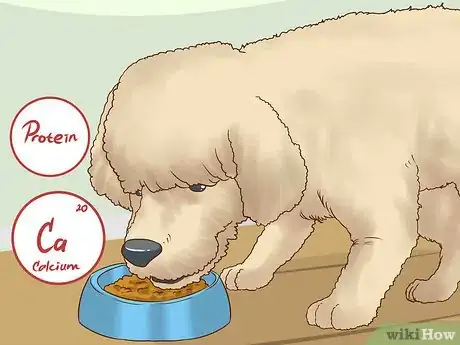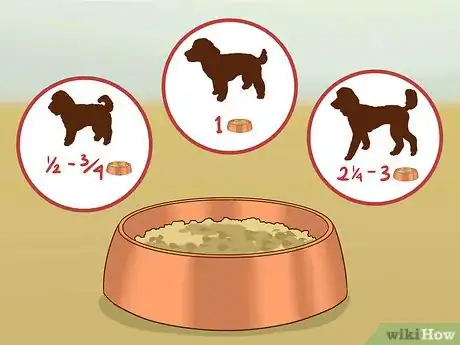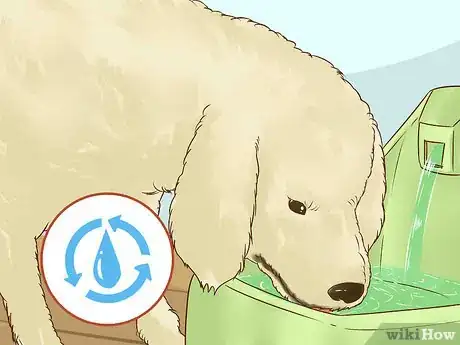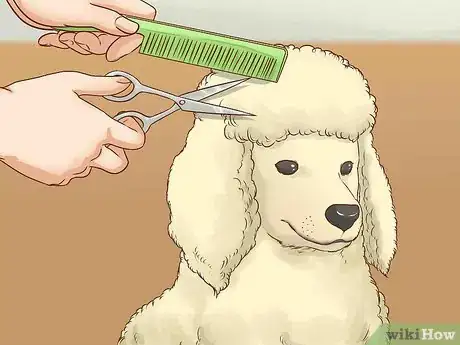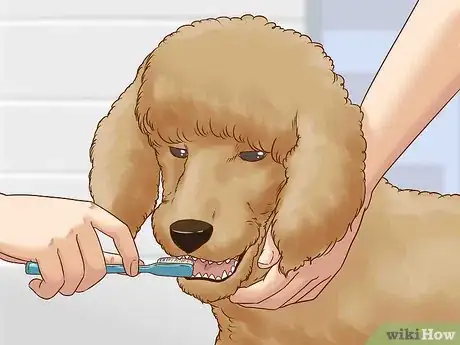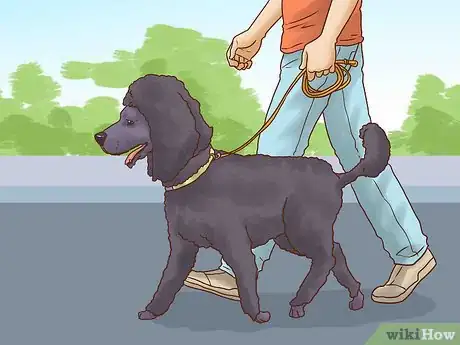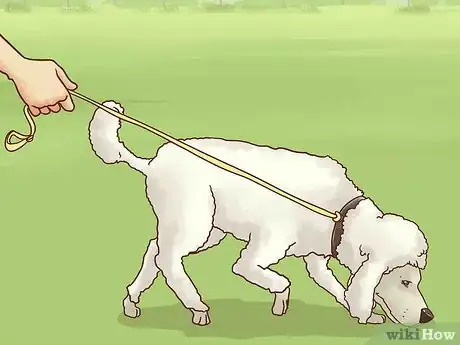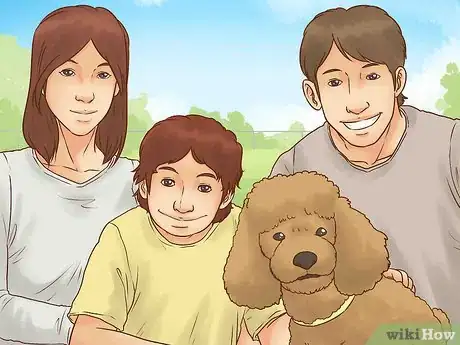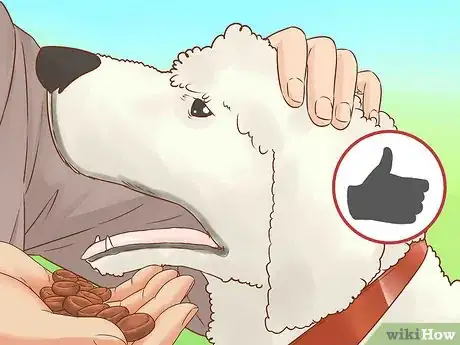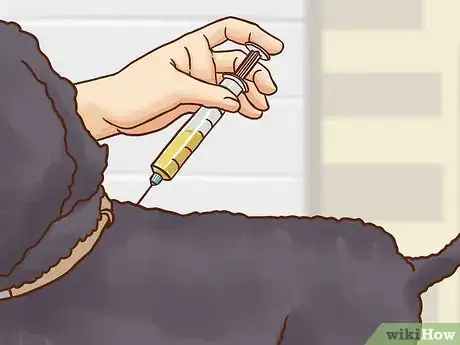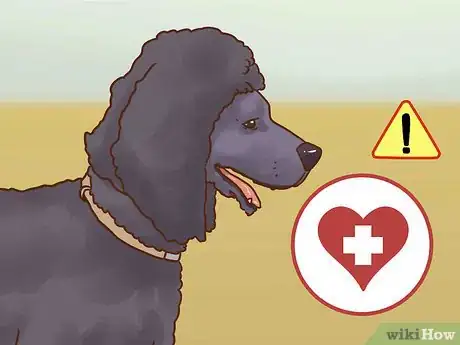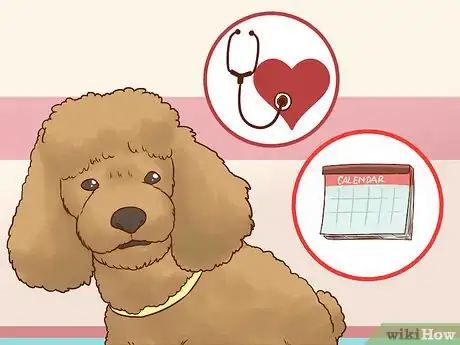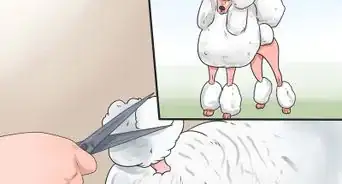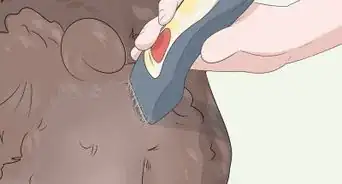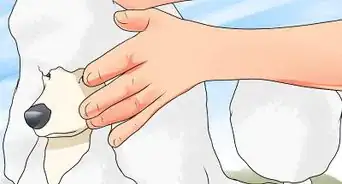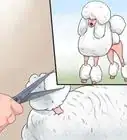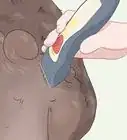This article was co-authored by Jaimie Scott. Jaimie Scott has been training dog owners as the Owner of Jaimie Scott Dog Training in Sacramento, California for the past 15 years. Jaimie meets clients for 1-on-1 training, group classes (owners only, no dogs), as well as live video classes. Jaimie has published videos, blog articles, and eBooks to share tips for training and his personalized insight into dog behavior. With a focus on training the owners, Jaimie believes that dogs need to know who’s in control at any given time in order to feel secure and be happy. Jaimie holds a BS in Mathematics and Computer Science from Pacific University.
There are 24 references cited in this article, which can be found at the bottom of the page.
wikiHow marks an article as reader-approved once it receives enough positive feedback. In this case, 97% of readers who voted found the article helpful, earning it our reader-approved status.
This article has been viewed 70,888 times.
Poodles are a popular breed of dog in many places around the world, loved for their active demeanors and sharp intelligence.[1] They're excellent hunters, trackers, trick-dogs, and even excellent watchdogs that will alert you whenever there's an intruder or something amiss in the household.[2] While they're not known for being extremely high-maintenance, there are some breed-specific things you should know about caring for a poodle. Learn how much and what kind of food, exercise, and grooming you should provide your poodle in order to keep it healthy and happy.
Steps
Feeding and Grooming Your Poodle
-
1Feed your poodle a diet rich in protein and calcium. There are many kinds of wet and dry dog food on the market, with prices and flavors varying across a diverse spectrum. Don't get overwhelmed by the variety, though. The most important thing about picking your poodle's dog food is that it contain 1 or 2 whole proteins—for example, “chicken meal” or “lamb meal” and not “poultry meal” or “meat by-product”—at the top of the ingredient list. Avoid foods with a grain or other filler listed as the top ingredient.[3]
- Many people choose to make their poodle's food in order to control the recipe and make sure no extraneous chemicals or additives go into it. There are many recipes for homemade dog food, but all of them should have 3 fundamental ingredients: meat, vegetables, and a filler carbohydrate such as rice.[4]
- No matter what prepared or homemade food recipe you opt for, there are certain foods which you should avoid at all costs. For example, keep your poodle away from raw meat, dried fruit, fried foods, and allium vegetables, such as onions and garlic.[5]
-
2Measure out a size-appropriate portion of food. There are 3 sizes of poodles: standard, which weigh between 40 and 55 pounds (18 and 25 kg), miniature, weighing between 12 and 15 pounds (5.4 and 6.8 kg), and toy, weighing 5 and 10 pounds (2.3 and 4.5 kg). The size of your poodle determines how much food you should give it, so make sure to follow recommended guidelines in order to avoid weight-related problems in the future.[6]
- You should consult your vet regarding your poodle's portions, as well as check the specific food labels on your dog food package. That being said, there are some rough guidelines you can use if such information is temporarily unavailable. Toy poodles should consume between ½ and ¾ cups of food per 24 hours, miniatures should have about 1 cup, and standards between 2 ¼ and 3 cups.[7]
Advertisement -
3Provide fresh, clean water at all times. Keeping your dog hydrated is essential to good health and nutrition: water lubricates and facilitates practically every function in your dog's body, including joint cushioning, temperature maintenance, and digestion. If you use wet food, your dog can get quite a lot of its daily hydration requirements from its food, but you should still provide a large bowl of clean water at all times.[8]
- You might want to consider purchasing a special pet fountain for your dog. Although many of these devices were created for cats who are attracted to running water, they perform multiple functions which are also beneficial to dogs, such as inhibiting bacteria growth and filtering out carbon.[9]
-
4Get your poodle groomed regularly. You've probably seen images of show poodles displaying what looks like a wacky, poofy grooming style.While you don't need to mimic this look in your pet's style, you still need to follow a fairly strict grooming regimen in order to keep your poodle's coat from matting. In addition to weekly brushing at home, you should get your poodle professionally groomed and trimmed every 6 to 8 weeks.[10]
- As a matter of fact, the poodle's trademark pompadours originated not as a decorative feature but out of necessity: having trained their poodles to retrieve ducks from the water, hunters needed a coat style that wouldn't waterlog and bog them down, but would also keep their joints and cardiovascular system warm in the low temperatures.[11]
-
5Brush your poodle's teeth. You should brush your poodle's teeth daily with a vet-approved canine toothpaste and toothbrush. If you've adopted an adult poodle who hasn't had prior daily dental care, get a professional cleaning done before beginning your daily regimen. This is especially important for toy and miniature poodles, as they tend to have more problems with receding gums.[12]
- You can further support your poodle's dental healthy by giving it rawhide bones and special dental treats to chew on. Just be sure to select a rawhide variety which contains no added flavor and is made in the U.S.A.[13]
Staying Active
-
1Walk your poodle multiple times a day. Poodles don't need as much exercise as some other energetic breeds, but you should still strive to walk them at least twice a day for no less than 20 minutes per walk.[14] This is particularly important for standard poodles, as they are the largest sized poodle and the most active. Toy and miniature poodles require less physical activity, but you should still make sure they get enough exercise to maintain a healthy cardiovascular and digestive system.
- A standard poodle can develop superior endurance and speed—some people have even trained for marathons with this boisterous breed! But, you should amp up activity gradually in order to avoid overheating.[15]
- Backyards can be a great resource to let the poodle run around and play, but, since poodles are highly intelligent and crafty dogs, make sure the yard is well-equipped with tall, durable fences. Scan your fences carefully for any holes or weaknesses before letting your dog run around, and don't let your dog be outside when you're not home to supervise.
-
2Do activities like field events and tracking. Poodles were originally bred in Germany to be trackers and water retrievers, so they have innately excellent senses of smell and intelligence. Field events, hunting, tracking, and agility exercises are all excellent options which let the poodle use these natural skill sets and interests while keeping it mentally engaged and physically active.
- Tracking training involves getting the dog to follow a tracklayer's scent over an extended distance, navigate obstacles in the terrain, and find and retrieve an object such as a glove or hat carrying the tracklayer's scent. If you're not familiar with the procedure, you can get help with this kind of training through local poodle organizations, obedience classes, or American Kennel Club chapters.
-
3Make your poodle a member of the family. Poodles are loving, giving dogs, but this also means they need tons of attention in return. They prefer to be with you at all times, so include your dog in anything you can. For example, take it with you to your kids' baseball game, out on your morning jog, and to your friends' barbecue.[16]
- Since poodles don't tolerate solitude very well, you should provide them with a distraction toy such as a Kong-type food delivery toy when you must leave them alone. Otherwise your poodle will act out and keep its mind occupied through other, often destructive behaviors, such as chewing on furniture or shoes.
-
4Use reward-based training methods to teach obedience skills.[17] Most experts agree that the best way to train a dog is through positive reinforcement—that is, rewarding behaviors you want the dog to do instead of punishing negative ones. In this approach, you give treats and/or verbal praise when the dog does something good or follows your commands, such as “sit,” “stay,” “look,” or come.” Just make sure that you give the treat and praise within a few seconds of the correct behavior, as otherwise your dog won't understand what they're being rewarded for.[18]
- Treats should be small, easily chewed, and healthy, so don't use human foods which get the dog used to salty snacks and can encourage begging. Using individual kernels of your dog's normal dry food or small pieces of roasted chicken or turnkey can be a good options.[19]
Visiting the Vet
-
1Get your poodle spayed or neutered. Unless you are a licensed dog breeder equipped with the necessary space and supplies to breed the poodle responsibly, your dog should be spayed or neutered. Female dogs are best desexed for health and population control reasons. If you have a male dog, talk to the vet about the pros and cons of neutering.
-
2Vaccinate your poodle. You should make sure to get your poodle the rabies, distemper, parvovirus, and adenovirus vaccines at the very least. You can also get a flu shot and other preventative shots for your poodle, but these are not strictly essential according to veterinary guidelines.
- For example, if you live in areas with high populations of rattlesnakes or ticks, you might want to consider getting special vaccinations against rattlesnake venom or lyme disease.
-
3Provide preventative treatments. Part of being a responsible owner includes making sure your dog receives regular treatments to prevent health problems. Your vet can provide medicine to prevent heartworms, fleas, ticks, and internal worms.
-
4Be aware of poodle-specific health problems. There are some diseases and conditions, such as Addison's and Cushing's disease, which affect poodles more than they do other breeds, so you should know what to look for and how to prevent developing problems.[20] Symptoms like itchiness, dry skin, or abnormal bumps call for a visit to the vet, while more serious symptoms such as difficult urination, distended abdomen, discolored gums, or cloudy eyes warrant a more urgent trip to the emergency clinic.[21]
- You should also watch out for symptoms of allergies. Poodles are not a breed particularly prone to food allergies, but keep an eye out for any symptoms such as itchy skin, excessive licking, or ear infections. If you notice any of these problems, visit your local veterinary office and see if they think food could be the cause of your dog's allergy.[22]
-
5Get yearly check-ups and blood screens. In addition to staying current on your dog's vaccines, you should take it to the vet every year for a standard check-up and blood tests. These tests will indicate any newly developing infections or diseases, and early detection of serious conditions like Addison's will greatly improve your dog's chances of recovery and life expectancy.[23]
- Be proactive about your dog's health by asking your vet some questions whenever you see them. For example, ask if your poodle's weight is within prescribed guidelines, if you should see a specialist about any ongoing problems, or if your dog should get a professional dental cleaning.[24]
- You also might want to consider purchasing health insurance for your poodle. While poodles are known as generally healthy dogs, veterinary costs can add up quickly if your poodle contracts a disease or has an accident. Ask your vet what they think about it and explore policy options online.[25]
Expert Q&A
Did you know you can get expert answers for this article?
Unlock expert answers by supporting wikiHow
-
QuestionHow do you do rewards-based training for dogs?
 Jaimie ScottJaimie Scott has been training dog owners as the Owner of Jaimie Scott Dog Training in Sacramento, California for the past 15 years. Jaimie meets clients for 1-on-1 training, group classes (owners only, no dogs), as well as live video classes. Jaimie has published videos, blog articles, and eBooks to share tips for training and his personalized insight into dog behavior. With a focus on training the owners, Jaimie believes that dogs need to know who’s in control at any given time in order to feel secure and be happy. Jaimie holds a BS in Mathematics and Computer Science from Pacific University.
Jaimie ScottJaimie Scott has been training dog owners as the Owner of Jaimie Scott Dog Training in Sacramento, California for the past 15 years. Jaimie meets clients for 1-on-1 training, group classes (owners only, no dogs), as well as live video classes. Jaimie has published videos, blog articles, and eBooks to share tips for training and his personalized insight into dog behavior. With a focus on training the owners, Jaimie believes that dogs need to know who’s in control at any given time in order to feel secure and be happy. Jaimie holds a BS in Mathematics and Computer Science from Pacific University.
Dog Owner Trainer Whenever your dog does something he's supposed to do, give him a command. Then, give him a small piece of food and praise as a reward. For example, if you want to teach your dog to sit, wait for him to naturally sit down, then say "sit" and reward him. This will help him associate the action with praise and treats. After your dog has gotten the hang of it, gradually reduce the treats you give him until he can do the command without them.
Whenever your dog does something he's supposed to do, give him a command. Then, give him a small piece of food and praise as a reward. For example, if you want to teach your dog to sit, wait for him to naturally sit down, then say "sit" and reward him. This will help him associate the action with praise and treats. After your dog has gotten the hang of it, gradually reduce the treats you give him until he can do the command without them. -
QuestionAre poodles mostly mellow, but occasionally playful?
 Community AnswerYes. Poodles are typically calm animals, but can choose to be playful when in an energetic mood.
Community AnswerYes. Poodles are typically calm animals, but can choose to be playful when in an energetic mood. -
QuestionAbout how many times will my poodle have to go to the bathroom?
 Community AnswerIt depends on what type of poodle you have. If you have a toy or miniature, you probably have to take them out 3-5 times a day (at least). But if you have a standard poodle, you probably have to take them out 2-3 times a day (at least). And that may or may not include play-time outside.
Community AnswerIt depends on what type of poodle you have. If you have a toy or miniature, you probably have to take them out 3-5 times a day (at least). But if you have a standard poodle, you probably have to take them out 2-3 times a day (at least). And that may or may not include play-time outside.
Things You'll Need
- A Leash
- Food
- Bowls
- Kennel
- Backyard
- Toys
References
- ↑ http://www.akc.org/dog-breeds/poodle/
- ↑ http://articles.latimes.com/1999/oct/25/local/me-26167
- ↑ http://www.whole-dog-journal.com/news/Approved-Dry-Dog-Food-List-How-to-Find-the-Best-Dry-Dog-Food-21347-1.html
- ↑ http://heavy.com/pets/2015/03/best-homemade-healthy-dog-food-recipes-ingredients/
- ↑ http://www.fda.gov/ForConsumers/ConsumerUpdates/ucm512230.htm
- ↑ http://www.vetstreet.com/dogs/poodle#overview
- ↑ http://www.petmd.com/blogs/nutritionnuggets/dr-coates/2015/july/are-you-feeding-your-dog-right-amount-32905#
- ↑ http://www.petmd.com/dog/nutrition/evr_dg_the_importance_of_water
- ↑ http://www.petmeds.org/petmeds-spotlight/benefits-of-water-fountains-for-cats/
- ↑ http://www.vetstreet.com/dogs/poodle#grooming
- ↑ http://www.slate.com/articles/news_and_politics/explainer/2004/02/why_are_poodle_haircuts_so_weird.html
- ↑ http://www.vipoodle.org/PDF_Files/VIP_Teeth.pdf
- ↑ http://www.caninejournal.com/rawhide-bones/
- ↑ http://www.akc.org/dog-breeds/poodle/care/
- ↑ http://www.oopsrescue.org/info/display?PageID=11468
- ↑ http://www.vetstreet.com/dogs/poodle#personality
- ↑ Jaimie Scott. Dog Owner Trainer. Expert Interview. 16 June 2020.
- ↑ http://www.humanesociety.org/animals/dogs/tips/dog_training_positive_reinforcement.html
- ↑ Jaimie Scott. Dog Owner Trainer. Expert Interview. 16 June 2020.
- ↑ http://www.poodleclubofamerica.org/all-about-poodles/health-concerns
- ↑ http://parkwoodanimalhospital.com/client-resources/breed-info/poodle-standard/
- ↑ http://moderndogmagazine.com/articles/food-allergies-dogs/15131
- ↑ http://www.poodlehealthregistry.org/docs/Standard/PHR_Standard_Addison.html
- ↑ http://www.petmd.com/dog/care/10-questions-everyone-should-ask-their-veterinarian
- ↑ http://www.caninejournal.com/cost-of-pet-insurance/
About This Article
To care for a poodle, feed it a diet that's high in protein and calcium, and make sure it has access to fresh, clean water at all times. You should also brush your poodle's fur once a week so it doesn't get matted. In addition to weekly brushings, have your poodle groomed every 6-8 weeks to keep its coat in good condition. Also, take your poodle for at least two 20-minute walks every day to burn off energy and help it maintain a healthy weight. For more advice from our Veterinary co-author, like how to train your poodle, scroll down!
